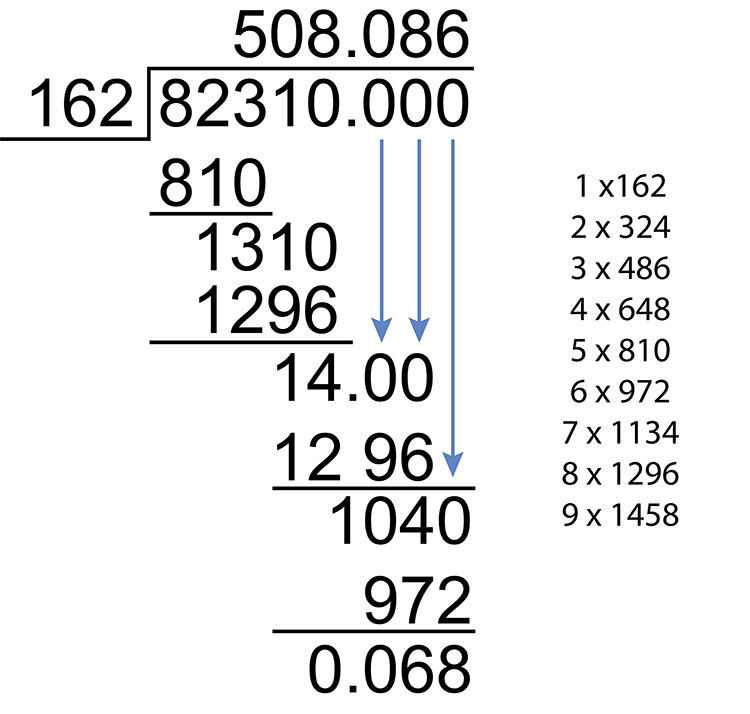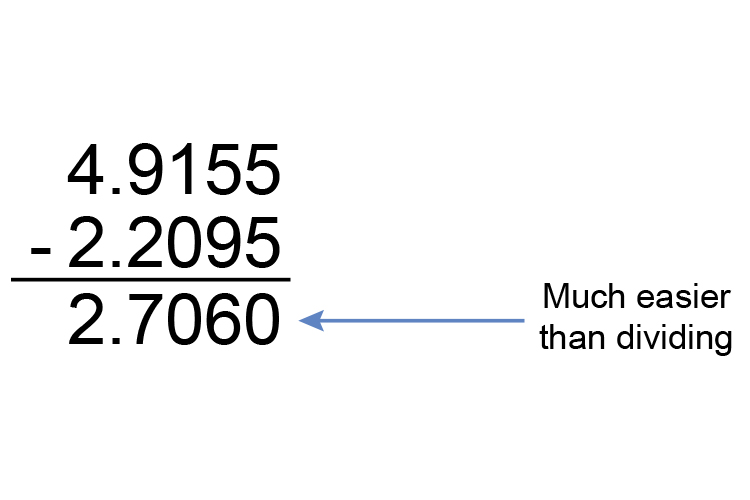Logarithms – divide large numbers traditionally
Before the early 1970’s; before students had calculators:
It was incredibly difficult when dividing large numbers not to make a mistake.
For example `82,310 ÷ 162`

Answer:
`508.086` remainder `0.068`
Seriously try this divide and see if you make a mistake (for clarity we left out the subtraction workings out).
Logarithms Divide
Mathematicians found an easier way.
Instead of dividing numbers
They subtracted powers (indices/exponents), and subtracting is a lot easier.
From our knowledge of indices:
`a^mdiva^n=a^m/a^n=a^(m-n)`
Or `10^3 ÷ 10^2 = 10^1`
`((10times 10 \times 10))/(10\ times 10) = (10)`
Here is the example again:
`82310 ÷ 162`
Is the same as `10^4.9155 ÷ 10^2.2095`
Subtract the indices

This equals `10^2.7060`
And `10^2.7060 = 10^2\times 10^0.7060`
`= 100\times 5.082`
`= 508.2`
(see below for explanation)
Explanation
So how did we convert `82310 ÷ 162` into `10^4.9155 ÷ 10^2.2095`
We use log tables (see reference log tables above)
First look up `82310`
Logs only work between `1` and `10`
And so `82310 = 10^4\times 8.231`
So we look up `8.231`
Here is part of the log table:

`0.9154 + 1` (to the last digit) = `0.9155`
Log table of `8.231 = 0.9155`
So `8.231 = 10^0.9155`
Therefore: `82310 = 10^4\times 8.231`
`= 10^4\times 10^0.9155`
`= 10^4.9155` (adding indices)
Now look up `162`
Logs only work between `1` and `10`
And so `162 = 10^2times1.62`
So we look up `1.62`
Here is part of the log table:
(Reference log tables/reference anti-log tables above)

Log table of `1.62 = 0.2095` which is spot on
So `1.62 = 10^0.2095`
Therefore: `162 = 10^2times1.62`
`= 10^2\times 10^0.2095`
`= 10^2.2095` (adding indices)
So `82310 ÷ 162` is the same as `10^4.9155 ÷ 10^2.2095`
Subtract the indices

This equals `10^2.7060`
The antilog tables
So how do we convert `10^2.7060` back to a normal number?
We use antilog tables (see reference antilog tables above)
Antilog `10^2.7060`
Antilogs only work between `0` and `1`
So `10^2.7060 = 10^2\times 10^0.7060`
`10^2 = 10\times 10 = 100`
And we must look up `0.7060`
Looking up `10^0.7060`
Here is part of the antilog table:

Antilog table of `0.7060 = 5.082`
So `10^0.7060 = 5.082`
Therefore `10^2.7060 = 10^2\times 10^0.7060`
`= 100times5.082`
`= 508.2`




